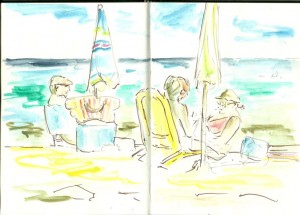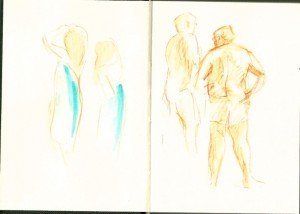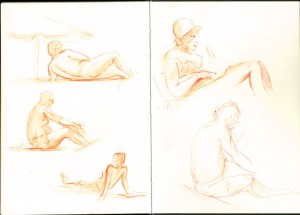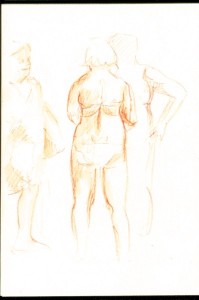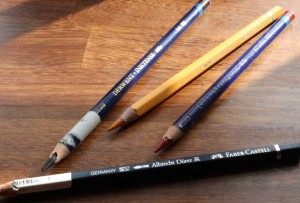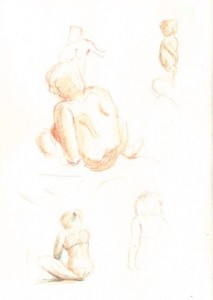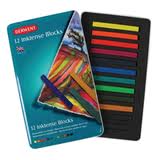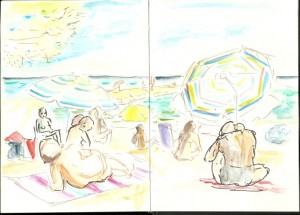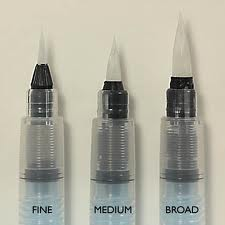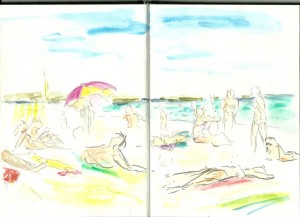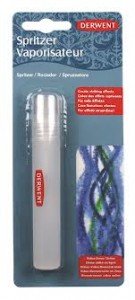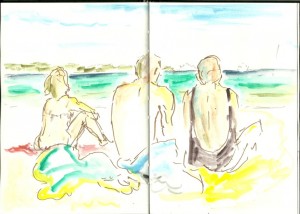Tips on sketching at the beach: Which materials to use
August 2, 2012
Holiday in southern France
A practical approach to sketching on the beach
A busy beach is a fantastic place to draw people. Some will rest in one position long enough for a quick sketch, though you may also wish to pay attention to those who are playing, stretching, drying their hair, etc.
Beach sketching has some advantages over life drawing in a studio. For a start, you can usually see the horizon behind the figures and this helps in establishing your eye level within the picture. Secondly, you have a wide choice of “models” at any one time and you can see how they appear either singly or in groups. These people find their own relaxed poses and that is something interesting to observe. Unlike the situation within a studio, an artist on the beach has a choice between drawing people nearby or at a great distance.
From the design point of view, beach sketching is fun. Parasols, towels and bags form blocks of colour within the scene. All kinds of compositions are possible and this is a good time to experiment.
How to go unnoticed
-
Surprisingly, the busier the beach, the less attention people will pay to you.
-
Set yourself up as one of the crowd by turning up with a beach towel and by wearing usual beach clothing.
-
Use an A5 sketchbook as this initially passes as a standard notebook to passers-by. Don’t set up an easel!
-
Wear sunglasses.
-
If you are using wet media, water brushes are less obtrusive than a collection of brushes and a pot of water.
-
Bring simple art materials. People will certainly come and look at what you are doing if you get out a set of paints.
It is good to stay unobtrusive so that people stay happy and relaxed around you. However, do remember to behave in a fair manner. Avoid staring unrelentlessly at anybody, especially topless ladies!
Choice of materials for sketching figures
I like the adaptability of water-soluble pencils. They are useful for line work and, once wetted, for areas of tone.
A red or red-brown pencil is good for sunlit figures. I do not attempt to match skin tone in any way, but red contour edges to figure drawings can suggest the glowing effect of skin in sunlight. My favourite is the Derwent Inktense pencil in mid vermilion.
To develop colour further while keeping it simple, I suggest carrying red, indigo blue and yellow water-soluble pencils. Again, I do not attempt to match skin tones, but can use the blue for cool shadow and the yellow pencil for warm highlights on skin.
Pencil marks can be left untouched, or blended with water. I carry a Pentel water brush filled with plain water for this job.
Choice of materials for colour and composition sketches on the beach
When sketching, and especially on holiday, I generally prefer to use bold-coloured media. There is the option of sitting on the beach with a neat box of watercolours, but that would perhaps tie me down to a traditional technique and feel rather limiting. In very bright sunlight (and, indeed, when working while wearing sunglasses) the delicate watercolour hues may be wasted in any case.
For bold line drawing, consider using Faber-Castell Pitt artist pens. These come in a good range of non-primary colours and are waterproof. If you are a little nervous of their bold lines, then make the first marks in the pale grey coloured pen, Warm Grey III272. This is also the pen to use for distant objects (I do not have the very pale cool grey – perhaps that one would be even better for distant objects).
I work over the pen lines with a variety of water-soluble media. The least obtrusive option is to fill several water-brush pens each with a different colour of diluted ink (I use FW acrylic inks). This is very convenient for general sketching and I do generally carry water-brushes filled with blue and green in my bag. Some brands of pen leak during transport, so be warned. The Pentel seems most reliable.
For beach sketching, I enjoy even bolder colours. On holiday in the south of France last week, I used a combination of Inktense colour blocks:
and Neocolour II sticks:
Thanks to Jamie Williams Grossman for the photograph of a complete set of Neocolour II sticks, above. Her blog features many tips on art materials to use when sketching outdoors (follow the link at the bottom of this post).
It is possible to achieve fantastic bright colours with either of these media. Neocolour II sticks can be obtained in a larger variety of colours than Inktense blocks, including rather subtle ones. These media work well in combination and can be overlaid to approximate a mixed colour.
For sketching on the beach, I wipe a water-brush pen over the Neocolour stick or Inktense block and then paint with the brush. To clean the tip of the brush, just squeeze a little water out of the brush pen before picking up a fresh colour.
Above: Brush pens are available in various sizes. These can be filled with water or ink.
Inktense sticks can become messy when wet. I just keep them in their original container and brush the water-brush against them without getting ink all over my hands.
There are plenty of other ways of working with Inktense blocks and Neocolour sticks. Both can be drawn with directly before working into the lines with water, ink or paint. They can also be used for drawing on wet paper. If you do wish to give this technique a try in your sketchbook, then consider getting a Derwent water mist spray:
Links
Jamie Williams Grossman’s sketching blog including tips on choice of materials and how to carry them.
Urban Sketchers website including sketch examples from different artists worldwide.
